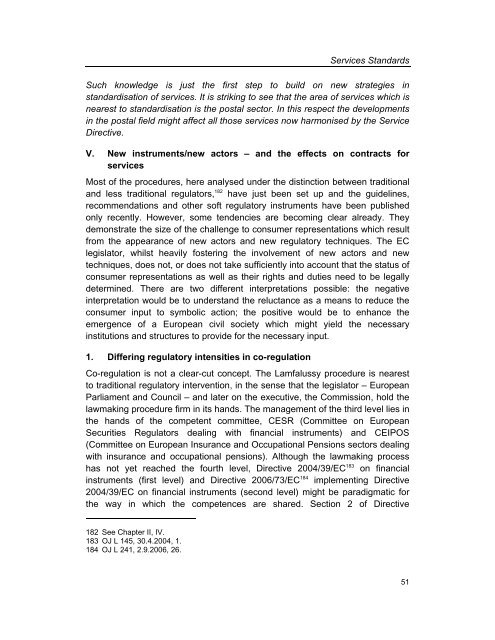Services Standards: Defining the Core Consumer Elements ... - ANEC
Services Standards: Defining the Core Consumer Elements ... - ANEC
Services Standards: Defining the Core Consumer Elements ... - ANEC
You also want an ePaper? Increase the reach of your titles
YUMPU automatically turns print PDFs into web optimized ePapers that Google loves.
<strong>Services</strong> <strong>Standards</strong><br />
Such knowledge is just <strong>the</strong> first step to build on new strategies in<br />
standardisation of services. It is striking to see that <strong>the</strong> area of services which is<br />
nearest to standardisation is <strong>the</strong> postal sector. In this respect <strong>the</strong> developments<br />
in <strong>the</strong> postal field might affect all those services now harmonised by <strong>the</strong> Service<br />
Directive.<br />
V. New instruments/new actors – and <strong>the</strong> effects on contracts for<br />
services<br />
Most of <strong>the</strong> procedures, here analysed under <strong>the</strong> distinction between traditional<br />
and less traditional regulators, 182 have just been set up and <strong>the</strong> guidelines,<br />
recommendations and o<strong>the</strong>r soft regulatory instruments have been published<br />
only recently. However, some tendencies are becoming clear already. They<br />
demonstrate <strong>the</strong> size of <strong>the</strong> challenge to consumer representations which result<br />
from <strong>the</strong> appearance of new actors and new regulatory techniques. The EC<br />
legislator, whilst heavily fostering <strong>the</strong> involvement of new actors and new<br />
techniques, does not, or does not take sufficiently into account that <strong>the</strong> status of<br />
consumer representations as well as <strong>the</strong>ir rights and duties need to be legally<br />
determined. There are two different interpretations possible: <strong>the</strong> negative<br />
interpretation would be to understand <strong>the</strong> reluctance as a means to reduce <strong>the</strong><br />
consumer input to symbolic action; <strong>the</strong> positive would be to enhance <strong>the</strong><br />
emergence of a European civil society which might yield <strong>the</strong> necessary<br />
institutions and structures to provide for <strong>the</strong> necessary input.<br />
1. Differing regulatory intensities in co-regulation<br />
Co-regulation is not a clear-cut concept. The Lamfalussy procedure is nearest<br />
to traditional regulatory intervention, in <strong>the</strong> sense that <strong>the</strong> legislator – European<br />
Parliament and Council – and later on <strong>the</strong> executive, <strong>the</strong> Commission, hold <strong>the</strong><br />
lawmaking procedure firm in its hands. The management of <strong>the</strong> third level lies in<br />
<strong>the</strong> hands of <strong>the</strong> competent committee, CESR (Committee on European<br />
Securities Regulators dealing with financial instruments) and CEIPOS<br />
(Committee on European Insurance and Occupational Pensions sectors dealing<br />
with insurance and occupational pensions). Although <strong>the</strong> lawmaking process<br />
has not yet reached <strong>the</strong> fourth level, Directive 2004/39/EC 183 on financial<br />
instruments (first level) and Directive 2006/73/EC 184 implementing Directive<br />
2004/39/EC on financial instruments (second level) might be paradigmatic for<br />
<strong>the</strong> way in which <strong>the</strong> competences are shared. Section 2 of Directive<br />
182 See Chapter II, IV.<br />
183 OJ L 145, 30.4.2004, 1.<br />
184 OJ L 241, 2.9.2006, 26.<br />
51
















